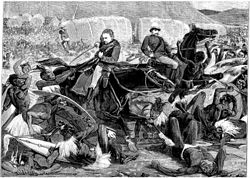伊散德爾瓦納戰役
伊散德爾瓦納戰役(英語:Battle of Isandlwana)發生於1879年1月22日-1月23日,為祖魯戰爭先期戰爭中,極為重要的戰役。在英國入侵南部非洲的祖魯蘭十一天后,一支由約20,000名祖魯戰士組成的祖魯軍隊襲擊了英國主力縱隊的一部分,該縱隊由約1,800名英國、殖民地和土著軍隊以及約350名平民組成。[11]祖魯人主要裝備傳統的阿塞蓋長矛(assegai)鐵矛和牛皮盾牌,[12]但也擁有一些毛瑟枪和老式步槍。[13][14]
| 伊散德爾瓦納戰役 | |||||||
|---|---|---|---|---|---|---|---|
| 祖魯戰爭的一部分 | |||||||
 泰格茅斯·梅爾維爾 †及內維爾·科吉爾 †兩位中尉帶著軍旗撤退 | |||||||
| |||||||
| 参战方 | |||||||
|
| 祖魯王國 | ||||||
| 指挥官与领导者 | |||||||
|
安東尼·鄧霍中校 † 亨利·普林少校 † |
Vumindaba kaNthati Mavumengwana kaNdlela | ||||||
| 兵力 | |||||||
|
第三縱列 |
祖魯部隊: | ||||||
| 伤亡与损失 | |||||||
|
超過1,300人戰死:[3] | 2,000人受傷[10] | ||||||
英國和殖民地軍隊配備了現代馬蒂尼-亨利後膛裝填式步槍和兩門7磅山炮作為野戰炮部署,[15][16]以及海爾火箭炮。祖魯人在武器技術方面處於巨大劣勢,[17] 但他們在數量上遠遠超過英國人,並最終壓倒了英國人,[18]殺死了1,300多名士兵,其中包括所有在前線的士兵。祖魯軍隊有1,000至3,000人陣亡。[19][20]
該戰役中,20,000名南非祖魯人成功伏擊了英國遠征軍進攻至伊散德爾瓦納的約1,700人前鋒。儘管面對著軍事裝備的巨大劣勢,但祖魯人最後仍以約1千至4千人的代價擊敗英軍,並令英軍戰死超過1,300人,幾乎全軍覆沒。祖魯人並趁此機會收復羅克渡口的原本失土。
這場戰鬥對祖魯人來說是決定性的勝利,並導致英國第一次入侵祖魯蘭的失敗。[21]英國陸軍在軍事技術落後的本土土著敵人面前遭受了最慘重的失敗。[17]伊散德爾瓦納戰役導致英國在盎格魯-祖魯戰爭中採取更激進的做法,導致第二次大規模入侵,[22] 並摧毀了开芝瓦约國王透過談判和平的希望。[23]
註解
编辑- ^ All figures from Holme, N. (1999) The Noble 24th: Biographical Records of the 24th Regiment in the Zulu War and the South African Campaigns, 1877–1879 pp. 377–78
- ^ Doyle, p. 120: "... around 20,000 ...". Colenso, p. 313, "The Zulu army, he (Nugwende) says, numbered 20,0000 ..." and p. 312, "... full nominal strength reaches a total of 30,900 men but the actual numbers are estimated at from 20,000 to 25,000
- ^ Knight (2002), p. 86
- ^ 4.0 4.1 4.2 Giliomee, Hermann; Mbenga, Bernard. New History of South Africa First. Tafelberg Publishers. 2007: 166. ISBN 978-0-624-04359-1.
- ^ Smith-Dorrien, Chapter 1D, "... nearly 900 British and 2,000 or 3,000 natives, friend and foe, had breathed their last on the fatal 22nd."
- ^ Lock, p. 224
- ^ Colenso, p. 312, gives 1333 also states a "given" total as 822 but says the actual loss is slightly higher
- ^ Knight, Ian. Isandlwana 1879: The Great Zulu Victory, Osprey, 2002, p. 86, "Zulu casualties were almost as heavy (as the British). Although it is impossible to say with certainty, at least 1,000 were killed outright in the assault...". Knight's estimate of Zulu casualties is more in keeping with those suffered by the Zulu at Kambula, where a British column forms an excellent defensive position with a wagon lager, six 7 pounder artillery pieces and 2,000 soldiers and inflicts 800 (counted bodies) – 1,000 killed on the Zulu. Similarly, Knight & Castle. Zulu War 1879: twilight of a warrior nation, 1992, p. 54 and in their Zulu War, 2004, p. 114, state that the Zulu casualties at Kambula and Isandlwana are comparable. Again, Ian Knight. Brave Men's Blood, The Epic of the Zulu War, 1879, (1990), p. 142, "785 [bodies] were collected from close by the camp", while there is a British pursuit at Kambula that inflicts many casualties on the Zulu, there is only the British retreat at Isandlwana during which the Zulu inflict many casualties. Also Laband, Historical Dictionary, 2009, p. 123.
- ^ Smith-Dorrien, Chapter 1D, "The next few days after the battle, St. Matthew's simile, " Wheresoever the carcase is, there will the eagles be gathered together," was fully illustrated, for literally the sky was darkened at times by continuous streams of " Aasvogels " heading from all directions to the battlefield marked by that precipitous and conspicuous crag, like a lion couchant, " Isandhlwana " where nearly 900 British and 2,000 or 3,000 natives, friend and foe, had breathed their last on the fatal 22nd." As can be seen from this account there were from both sides a total of 2 to 3 thousand natives killed.
- ^ Victor David Davis Hanson, "Carnage and Culture: Landmark Battles in the Rise to Western Power", p. 282, Anchor Books, 2002. Hanson highlights Zulu accounts of how simply being hit by a Martini Henry .45 slug was usually enough for a crippling or maiming wound and in the absence of effective medical care, many wounded Zulus died, within several hours or a few days as result of wounds sustained at Isandlwana.
- ^ Knight (2002), p. 49, Knight gives a total of 1,768 combat troops, not including wagon drivers and other civilians, of which there were some 350, Colenso, p. 263
- ^ Christon I. Archer World History of Warfare, Univ of Nebraska Pr, 2008, ISBN 0-8032-1941-5, p. 462 "They had a national army of twenty-five thousand men equipped with cowhide shields, assegais and clubs."
- ^ Smith-Dorrien, Chapter 1B "It was a marvellous sight, line upon line of men in slightly extended order, one behind the other, firing as they came along, for a few of them had firearms, bearing all before them." eyewitness account, emphasis added
- ^ Ian Knight, Angus McBride Zulu 1816–1906[永久失效連結], Osprey Publishing, 1995, ISBN 1-85532-474-1, p. 25
- ^ Hall, Major D.D. Artillery in the Zulu War – 1879. Military History Journal (The South African Military History Society). January 1979, 4 (4).
- ^ John McAdam, FRGS, "The Role of the Royal Artillery during the Anglo Zulu War". [13 March 2014]. (原始内容存档于13 March 2014).
- ^ 17.0 17.1 Doyle, p. 118: "It was here ... the British Army suffered its worst ever defeat at the hands of a technologically inferior indigenous force." (emphasis added)
- ^ Morris, pp. 366–67
- ^ When Spears Beat Cannons: The Battle of Isandlwana. 29 December 2020.
- ^ Ian Knight Rorke's Drift 1879 Osprey Publishing, 1996, ISBN 1-85532-506-3.
- ^ Thompson, p. 75 "Thus ended the first British invasion of Zululand." Knight (2003), p. 27 Map titled: "First invasion of Zululand".
- ^ Morris, pp. 498–511, Chapter 'The Second Invasion'
- ^ Spiers, p. 42, "... reports of the annihilation ... prompted the Cabinet to send reinforcements and galvanized interest in the war." Ian Knight, Zulu War, Osprey, 2004, p. 11, "The home government, embarrassed by Isandlwana, sought to restore British honour by despatching more reinforcements ..."
外部連結
编辑- Zulu: The True Story By Dr. Saul David
- Isandlwana battlefields
- Personal account of the battle by Horace Smith-Dorrien
- Zulunet description of the battle
- Secrets of the Dead – Day of the Zulu 互联网档案馆的存檔,存档日期11 November 2012.
- Travellers Impressions
- The Battle of Isandlwana
- The Battle of Isandlwana 22 January 1879, Ian Knight video [1]
- Forgotten Heroes Zulu & Basuto Wars, Roy Dutton,/ [https://www.roydutton.co.uk/my-books/forgotten-heroes-zulu-basuto-wars/